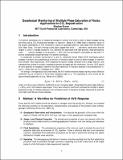Geophysical Monitoring of Multiple Phase Saturation of Rocks: Application to CO[subscript 2] Sequestration
Author(s)
Brown, Stephen
DownloadBrown_avo_part2.pdf (538.0Kb)
Other Contributors
Massachusetts Institute of Technology. Earth Resources Laboratory
Metadata
Show full item recordAbstract
4-D seismic techniques rely on measuring changes in velocity over time in order to detect changes during activities such as CO[subscript 2] flooding and storage in a reservoir. Wang et al. [1998] detail a laboratory study of the seismic detectability of CO[subscript 2] flooding in a series of carbonate reservoir rocks taken from the McElroy field, West Texas. The basic findings of the paper suggest that while “ . . . laboratory results show that the largest V[subscript P] and V[subscript S] changes caused by CO[subscript 2] injection are associated with high-porosity, high-permeability rocks, . . . ” velocity changes in low-porosity (< 10%) and low-permeability carbonates are less than 1% and are undetectable using traditional 4-D seismic techniques.
Date issued
2011Publisher
Massachusetts Institute of Technology. Earth Resources Laboratory
Series/Report no.
Earth Resources Laboratory Industry Consortia Annual Report;2011-09
Keywords
AVO, CO2, Fluid flow